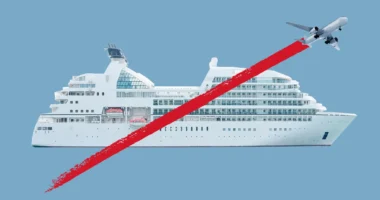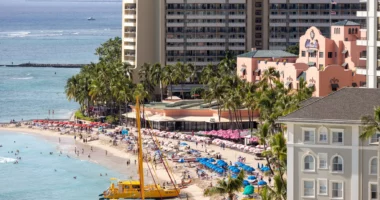Paris to Venice. Barcelona to Amsterdam. Brussels to Bratislava, Slovakia. European cities could see a flurry of new rail connections in the next few years, as governments and private investors respond to climate concerns and strive to keep up with strong demand for cross-border passenger rail traffic.
Patience is required: Some new connections will take a year or more to start operating, and there will be the occasional inconveniences — like the six-month suspension of nonstop service from Amsterdam to London beginning in June, as Amsterdam’s Central Station undergoes renovations.
The route that passes under the English Channel could also have some slow-building changes in the works. Eurostar has had a monopoly on passenger rail traffic under the Channel for nearly 30 years. But the Channel Tunnel is open access, and competitors are lining up to offer additional services between Britain and the continent.
It’s all part of Europe’s ongoing rail renaissance, which is being driven in large part by strong interest from passengers.
“For long-distance travel, trains are full — and we have more demand than supply. This is true for day trains as well as night trains,” said Alberto Mazzola, the executive director of the Community of European Railway and Infrastructure Companies, a Brussels-based industry group.
He attributed the rise in demand to passengers’ concerns about the climate as well as trains’ increasing price competitiveness with flights. For example, on Thetrainline.com, a popular platform for train bookings in Europe, a round-trip rail journey between Paris and Geneva in late January starts at 63 euros, or about $69, including luggage. On Google Flights, the cheapest round-trip ticket is 148 euros, not counting fees for checked luggage or airport transfers.
“The big problem that we have is lack of infrastructure,” Dr. Mazzola said, noting that train stations are the biggest bottleneck, followed by capacity on the lines themselves. Governments, including in Germany and France, are making major investments in infrastructure, he added, although these projects could take several years to bear fruit.
But passengers are ready to go. Across the European Union, passenger rail transport saw a 50 percent jump between 2021 and 2022, landing at nearly 245 billion miles traveled — just five percent shy of 2019 levels. Based on feedback from rail operators around Europe, Dr. Mazzola expects to see the trend continue when 2023 data are released.
Cross-Channel competition
Gwendoline Cazenave, the chief executive of Eurostar, said that growth is also strong on the cross-Channel route, where passenger numbers for 2023 were close to their prepandemic high of over 11 million.
“The demand for sustainable railway travel is really booming,” Ms. Cazenave said, adding that by 2030, Eurostar aims to transport 30 million passengers every year across its network — which includes stops in the Netherlands, Belgium and Germany, as well as Britain and France.
Competitors are taking note, especially on the cross-Channel route.
“People have realized that it’s a lucrative market, and Eurostar is helping them by pricing high,” said Mark Smith, the founder of the rail travel website The Man in Seat 61 and a former station manager at London’s Charing Cross station. Mr. Smith noted that he has “never seen this much interest” from potential competitors, and that a successful challenger could be good news for passengers.
“There is no doubt that rail-on-rail competition keeps fares down,” Mr. Smith said. (A recent search revealed that a round-trip Eurostar trip between Paris and London in late January started at 141 euros, or about $154, compared to 64 euros for round-trip flights, not including luggage fees.)
In October, Evolyn — a new rail operator led by the Spanish Cosmen family, travel-industry heavyweights — announced that it had reached an agreement with the French train manufacturer Alstom to secure between 12 and 16 high-speed trains for the cross-Channel route.
“There is room for business there,” said Estefanía Campos, a spokeswoman for Evolyn. She added that the company’s cross-Channel service would begin in 2025, with full operations coming online in 2026.
The British businessman Richard Branson could also be preparing a bid. In November, The Telegraph, citing unnamed sources, reported that Mr. Branson, the owner of Virgin Group, a multinational venture capital corporation, was “plotting a rival operation” on Eurostar’s flagship route. When asked about the news article, the company said that it “doesn’t comment on rumor or speculation.”
Heuro, in the Netherlands, also announced plans for a cross-Channel route. Direct service between Amsterdam and London, with up to 16 trains per day traveling in each direction, is scheduled to begin in 2028.
Roemer van den Biggelaar, a Heuro co-founder, noted that there are now more than 50 flights a day between Amsterdam and London, compared to only four or five train departures. “We need to shake up this market,” said Mr. van den Biggelaar. “We need someone with a vision to come along and say, ‘OK, guys, let’s work together to get all those people out of the planes.’”
But any challenger will face logistical challenges. New European border controls planned for late 2024 will mean that non-European passengers setting off from London will have to go through a biometric security check — including facial recognition and fingerprints — before they board their train across the Channel.
And both the St. Pancras Station in London and the Gare du Nord in Paris would have to undergo renovations to make space for additional trains and passengers. Ms. Campos of Evolyn and Mr. van den Biggelaar of Heuro said their companies were working with the relevant authorities to find solutions.
But there is plenty of space for competitors.
“This is an open-access tunnel, so there’s no favoritism in that,” said John Keefe, a spokesman for GetLink Group, the company that manages the rail infrastructure under the Channel. “There is room for more high-speed trains to run through the tunnel,” he said.
Other new connections
Competitors may be lining up for the London-Paris route, but elsewhere startups are among those looking to build direct connections where none now exist.
In May, the Dutch-Belgian company European Sleeper started overnight service between Brussels and Berlin. It is scheduled to extend to Dresden, Germany, and Prague in the spring. European Sleeper is also planning direct service between Amsterdam and Barcelona in 2025.
Meanwhile, Midnight Trains, a Paris-based startup, is working to build overnight routes in and out of Paris — including to Milan, Venice, Florence, Rome, Barcelona and Madrid. They plan to launch the first service, Paris-Milan-Venice, in 2025.
And in Central Europe, Leo Express, based in Prague, already operates a network that connects the Czech capital to Krakow and Bratislava, among other cities. The company has applied for approval to begin running a daily 19-hour service between Bratislava and Brussels, which could launch as soon as late 2024.
The national railways are also involved.
In September, the German transport minister, Volker Wissing, vowed to free up 40 billion euros, about $43.6 billion, to revitalize the country’s rail network. “The rail infrastructure has been neglected for decades and brought to its absolute limits,” Dr. Wissing said in a statement. “This is no longer acceptable and unworthy of a progressive economic nation. We need the railroads as a climate-friendly mode of transport.”
In Spain, the government has opened up its high-speed rail network to private competition with great success. And the national rail operator, Renfe, recently started direct services between Madrid and the French coastal city of Marseille, and between Barcelona and Lyon, France.
And in France, President Emmanuel Macron promised in 2020 to revitalize the country’s rail network to promote the country’s “ecological transition.” Overnight services have recently restarted between Paris and Nice, Paris and Vienna, and Paris and Aurillac, in the south.
Paris is also now enjoying direct overnight service to and from Berlin, the result of a collaboration between the national railway companies of France, Germany, Belgium and Austria. The French transport minister, Clément Beaune, was among those aboard the inaugural train, which pulled into Paris’s Gare de l’Est on the morning of Dec. 12.
“It was magnificent,” Mr. Beaune told a reporter waiting to greet him on the platform. “It’s a symbol that we need at the moment.”





